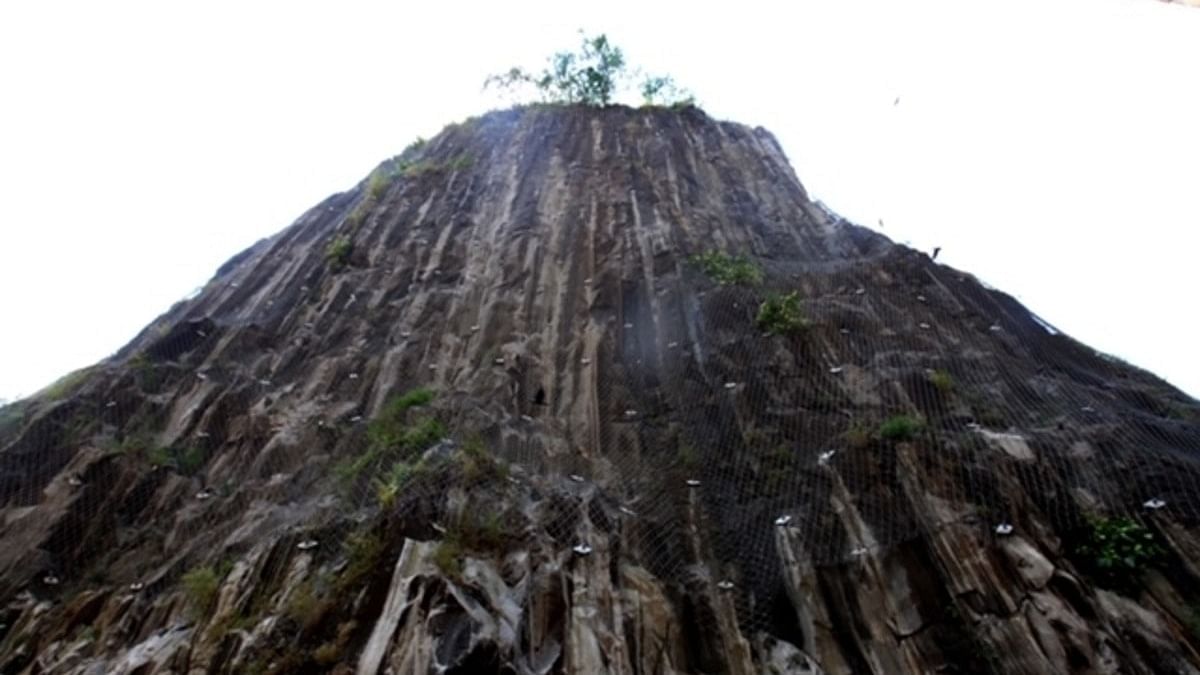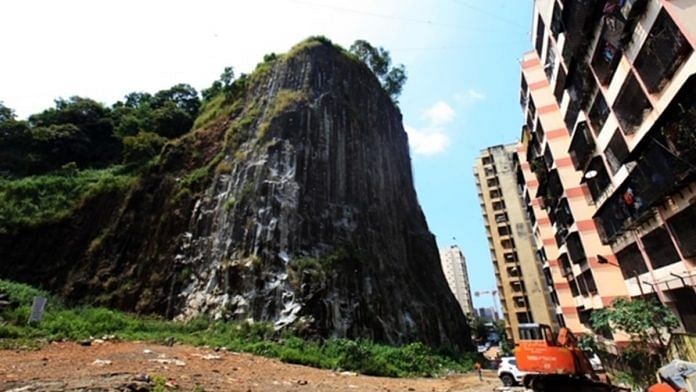Mumbai: On 27 September, marked as World Tourism Day, Maharashtra Chief Minister Uddhav Thackeray spoke about preserving a Mumbai structure that is rare and special, but has been reduced to a trifling hillock, standing insignificant amid tall dowdy high rises, encroachments and garbage in the dense northern suburb of Andheri.
This is Gilbert Hill, a 200-foot monolithic column made of black basalt that is one of Mumbai’s oldest geological structures, formed 66 million years ago when molten lava spewed out of earth’s clefts.
What makes Gilbert Hill even more special is the fact that across the world, there are only two more such geological formations of its kind, both in the US — the Devils Postpile National Monument in California, and the Devil’s Tower National Monument in Wyoming.
“In the United States, these structures have been preserved as national monuments and tourist sites,” CM Thackeray said Sunday.
The story of Gilbert Hill, however, is a pitiful tale of neglect and erosion due to the apathy of successive governments over the years, including the Brihanmumbai Municipal Corporation (BMC) helmed by Thackeray’s Shiv Sena for more than two decades.
Also read: 8 hours just to get to & from work — why despite opening up, travel in Mumbai is a nightmare
From dinosaurs to urban mess — the journey of Gilbert Hill
The Gilbert Hill dates back to the Mesozoic Era, a geological age spanning from 252 million years ago to 66 million years ago, when large reptiles and dinosaurs lived on earth. It is evidently much older than some of Mumbai’s other famous landmarks such as the Elephanta Caves and the Gateway of India.
In 1952, the Central government declared Gilbert Hill as a ‘National Park’ under the Forest Act to put a stop to all quarrying activity that was chipping away at the hill. The quarrying, however, didn’t stop until about two decades ago.
“Continuous construction nearby proximity to the hill caused damage to the structure and deteriorated the base of the hill. Moreover, these construction activities along with drastic rainfall contributed to frequent rockfall events that caused severe damage and loss of human life,” said a June 2016 paper on the risk assessment and protection measures for Gilbert Hill.
It was authored by M.K. Ansari, M. Ahmad and T.N. Singh from the Indian Institute of Technology (IIT), Bombay, and Rajesh Singh from the University of Lucknow.
“The Gilbert Hill belongs to Deccan trap basalts of 66 million years old and mainly composed of compact basalt, which is intrusive into stratified tuffaceous breccia. The intrusion is nearly circular in nature and was once spread over an area of 50,000 square kilometres. In present time, most part of the hill has been quarried resulting in reduction in the area of the Gilbert Hill,” the report added.
Today, the structure is flanked by buildings almost as tall as the hillock at a stone’s throw, shanties with tin roofs, and garbage spewed all around the hillock’s base. A steep flight of stairs up the hill leads visitors to a Gaondevi Durgamata temple atop. Parts of the hill are also chipping away due to constant landslides.

Earlier, the Gilbert Hill could be seen from even a considerable distance in the suburbs, but as the slum encroachments around the hill turned into in situ slum redevelopment projects, tall buildings gradually came up nearby, eclipsing views of the geological marvel.
Vikas Dilawari, a Mumbai-based conservation architect who until 2014 was the head of the conservation department at the Kamla Raheja Vidyanidhi Institute of Architecture, said the Gilbert Hill is like a Parel mill chimney today.
“Earlier, you could see the towering mill chimneys from afar, now you can only see them up close in Parel. Nevertheless, the Gilbert Hill is the most amazing site in the city, but we have ignored it,” he said.
“It is a vantage point that throws up spectacular views of Mumbai’s suburbs. You can see flights landing and taking off. You can see the Juhu beach and the Versova beach. You can even see the Aarey colony and other smaller hillocks in the city, among other things. It gives a 360-degree panoramic view apart from its geological features of columnar basalt,” Dilawari said.
“Ideally, it has several institutions around with open space. If we could have used it as a large integral open space or lung or a suburban scale park it would have been ideal as the city requires such intervention. If the government is planning to take steps to restore and conserve Gilbert Hill, it is a welcome move,” he added.
Also read: Shiv Sena is ready with another ‘sons of the soil’ ploy — this time for poll-bound Bihar
On city’s heritage list, but only a Grade 2 structure
In 2007, the Bombay High Court formed a two-member expert committee to look into the conservation of Gilbert Hill while hearing a PIL on the issue. “Is there even an inch of land that you want to leave vacant in Mumbai?” the then Chief Justice Swatanter Kumar had questioned the BMC.
The committee recommended a ban on any further excavation and construction activities in a 5-metre area around the hill.
The same year, the BMC included Gilbert Hill in the city’s list of heritage structures. The hillock was, however, classified only as a Grade 2 structure, which allows development around it, unlike a Grade 1 heritage structure where no development is permitted in a radius of 100 metres.
The builder lobby, meanwhile, has remained apathetic to the significance of Gilbert Hill.
In 2011, in response to a petition in the Bombay HC by trustees of the Gaondevi Durgamata temple along with local activists, two developers submitted an affidavit saying the site is neither a geological nor an archaeological monument.
Last year, a developer was also found to be excavating a portion of the hill and was issued a stop-work notice by the Mumbai suburban collector.
“Overall, there has been a lot of construction work around Gilbert Hill that seems to have weakened the structure by causing water seepage in the hill. We’ve worked on restoring and strengthening the hill over the past two years,” said an official from the state public works department, who didn’t wish to be named.
Also read: Fear of second Covid wave as people moving out, says Maharashtra CM Uddhav Thackeray
Structure strengthened
The public works department has undertaken a four-phased project to strengthen Gilbert Hill and spruce it up. It even roped in experts from IIT-Bombay to study Gilbert Hill in its current state and recommend measures to restore it.
Accordingly, the state public works department has strengthened most of Gilbert Hill with bolts and a protective net. Next, the department plans to install an elevator to go up and down the hill and beautify a small area around the hill to encourage more tourists.

Meanwhile, the tourism department, which CM Thackeray’s son Aaditya Thackeray heads, is also considering plans to beautify Gilbert Hill and make it a popular tourist spot.
Ameet Satam, local MLA from the Bharatiya Janata Party, who has been pushing for the restoration of the Gilbert Hill since 2012, said, “Last year, after the Navratri festival, the steps on Gilbert Hill caved in. So, we had to come up with a tender to fix them and get them repaired.”
He added, “We have made considerable progress since I became MLA. People may come now and say we will do this, and we will do that but nobody has been able to answer why it was ignored for so long.”
Also read: How Aaditya Thackeray’s using Covid downtime to prep Maharashtra as post-pandemic tourist hub



